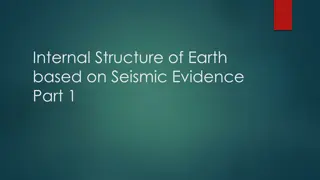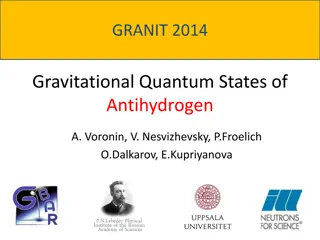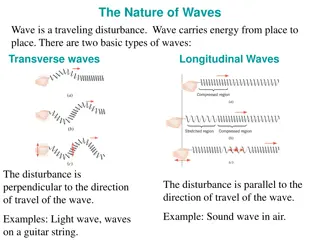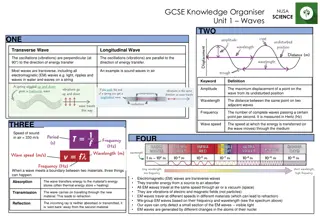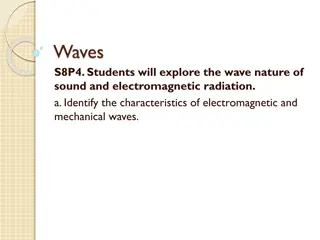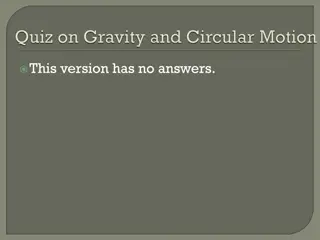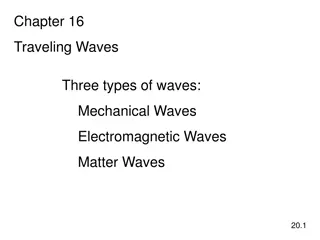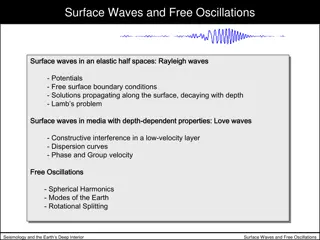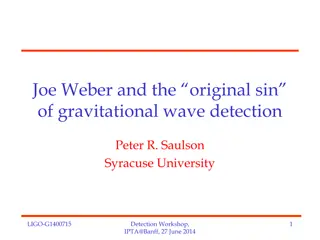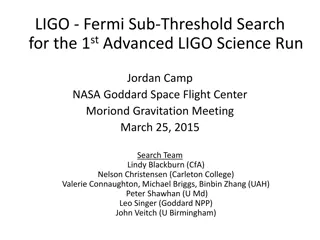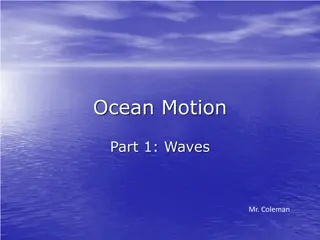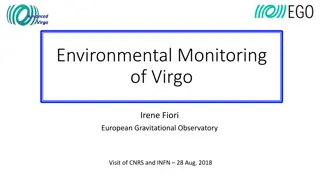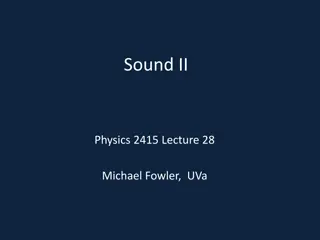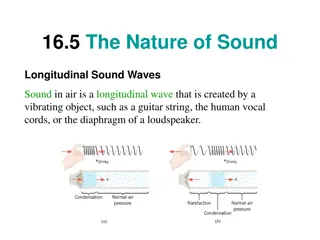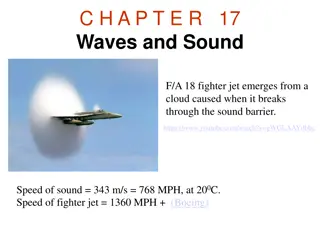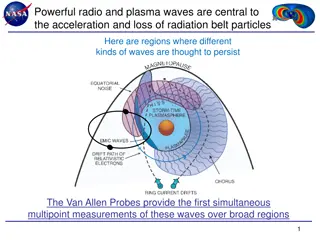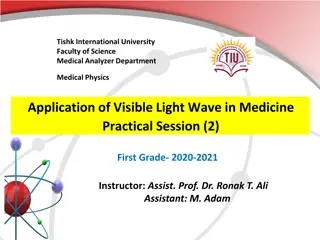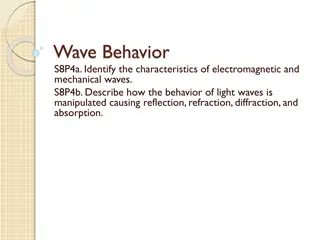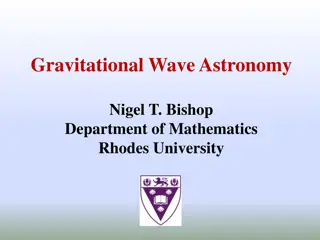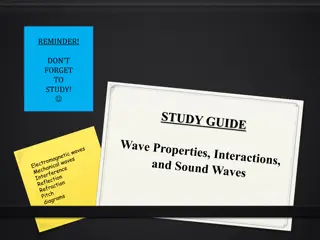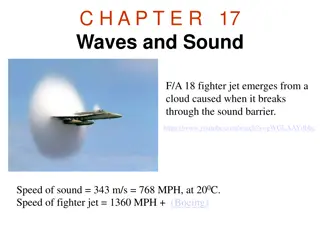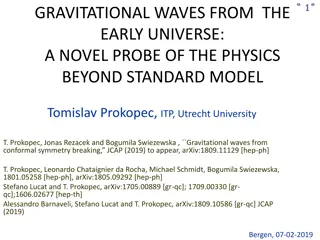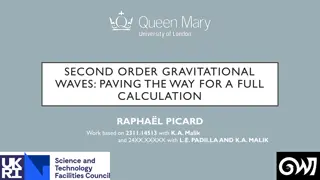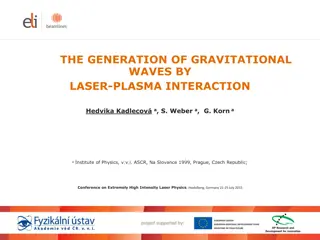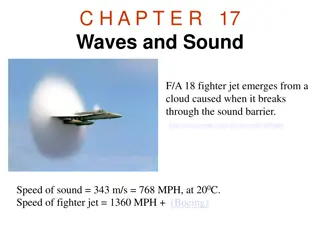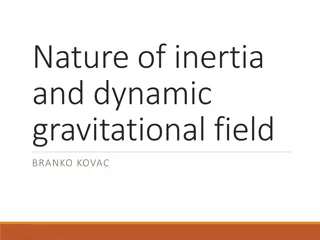Earth's Interior through Seismic Waves: Part 1
Seismic waves provide crucial evidence about Earth's composition and structure. By analyzing the behavior of primary, secondary, and surface waves, scientists can determine the different layers and materials within the Earth. Primary waves travel through both solid and liquid parts, while secondary
11 views • 10 slides
Exploring Types of Waves and Energy Transport
Discover the various types of waves such as transverse, longitudinal, surface, and electromagnetic waves, along with their characteristics and applications in energy transportation. Learn about the differences between mechanical and electromagnetic waves, how waves transmit energy, and their signifi
3 views • 10 slides
Waves: A Visual Exploration
Explore the fascinating world of waves through visually engaging images and interactive clickers. Learn about different types of waves, including longitudinal and transverse waves, and discover what waves carry - energy, not matter. Delve into the concepts of mechanical and electromagnetic waves, an
3 views • 37 slides
General Plane Waves in Electromagnetic Theory
This study focuses on the analysis of general plane waves in electromagnetic theory, covering topics such as the general form of plane waves, Helmholtz equation, separation equation, wavenumber vector, Maxwell's equations for plane waves, and the symbolic representation of plane waves. The content d
0 views • 41 slides
Interference and Beats in Waves
Explore the fascinating phenomena of interference and beats in waves, where overlapping waves interact to create patterns of constructive and destructive interference. Witness how sound waves can also produce beats when interfering in time, resulting in a slow envelope effect. Delve into the princip
1 views • 40 slides
Gravitational Quantum States of Antihydrogen
The research delves into the intriguing realm of gravitational quantum states of antihydrogen, posing questions about the feasibility of gravitational mass extraction from these states. Through topics like spectroscopy, interference, and time-spatial resolution, the study sheds light on the properti
1 views • 21 slides
Indian Contributions to General Relativity Post-Independence Era
Indian scholars have made significant contributions to the field of General Relativity post-independence, focusing on important problems like Big Bang singularity, gravitational collapse, black holes, gravitational waves, and quantum aspects. Notable achievements include AKR's Raychaudhury Equation,
0 views • 30 slides
Gravity Waves as a Mechanism of Coupling Oceanic and Atmospheric Acoustic Waveguides to Seismic Sources
Direct excitation of acoustic normal modes in horizontally stratified oceanic waveguides is negligible for shallow earthquakes due to velocity disparities. This study evaluates the contribution of scattering by hydrodynamic waves in generating abyssal T-waves. The research explores the role of scatt
1 views • 6 slides
The Nature of Waves and Sound
Understanding the nature of waves, both transverse and longitudinal, and their properties such as amplitude, wavelength, and frequency. Delve into the world of water waves, periodic waves, and the speed of waves on a string. Learn about the longitudinal nature of sound waves, the audible frequency r
1 views • 16 slides
Waves: Properties, Behaviors, and Applications
Waves come in different forms - transverse and longitudinal - each with distinct characteristics and behaviors. Understanding concepts like amplitude, wavelength, frequency, and wave speed is crucial in grasping how waves transfer energy through different materials. The interaction of waves with bou
1 views • 9 slides
Waves: Characteristics and Types Explained
Explore the wave nature of sound and electromagnetic radiation, distinguishing between electromagnetic and mechanical waves. Waves are energy-carrying disturbances that do not transport matter. Mechanical waves require a medium for energy transfer, while electromagnetic waves can travel through spac
2 views • 26 slides
Concepts in Gravitational Forces and Celestial Bodies
This informative content delves into various concepts related to gravitational forces and interactions between celestial bodies like the Earth and the Moon. It covers topics such as the comparison of gravitational pulls, forces in concentric orbits, weight measurements in different scenarios, and th
1 views • 11 slides
Traveling Waves: Types, Properties, and Equations
Explore the world of traveling waves, including mechanical, electromagnetic, and matter waves. Learn about transverse and longitudinal wave motion, the speed of waves in strings, wave frequency, wavelength, and speed relationships, as well as wave equations for non-repeating waves over space and tim
1 views • 30 slides
Standing Waves in Physics
Standing waves in physics are periodic waves that result from the interference of reflected and inverted waves, creating nodes and antinodes along a medium. These standing wave patterns can be observed in vibrating strings, such as guitar strings, where specific frequencies produce distinct harmonic
1 views • 29 slides
Surface Waves and Free Oscillations in Seismology
Exploring surface waves, potentials, and free oscillations in seismology with a focus on Rayleigh waves, Love waves, and wave equations. Understand the dispersion relation, geometry, and solutions for waves propagating in elastic half spaces and media with depth-dependent properties.
0 views • 55 slides
The Legacy of Joe Weber in Gravitational Wave Detection
Joe Weber, a key figure in the history of gravitational wave detection, made significant original contributions to the field, despite facing conflicts and challenges. His groundbreaking work laid the foundation for future advancements in the detection of gravitational waves. The story of Joe Weber's
1 views • 19 slides
Advanced LIGO and Short Gamma-Ray Burst Search Overview
Advanced LIGO is focused on achieving a lower noise level and higher sensitivity to detect gravitational waves. The search involves analyzing data from the 1st Advanced LIGO Science Run, collaboration with Fermi, and seeking coincident detections of gravitational waves and gamma-ray bursts, particul
1 views • 13 slides
Ocean Waves and Their Dynamics
Exploring the science behind ocean waves, this resource delves into why waves occur, the components of a wave, how water moves within a wave, and the effects of waves hitting a beach. From defining waves to discussing wave characteristics, this content provides valuable insights into the fascinating
1 views • 13 slides
Environmental Monitoring of Virgo Irene Fiori European Gravitational Observatory Visit
The environmental monitoring of Virgo at the European Gravitational Observatory involves studying various environmental influences on the interferometer, such as electromagnetic fields, radio waves, ground motion, and mechanical vibrations. Sensors are strategically placed in experimental halls to d
0 views • 12 slides
Sound Waves: Harmonic Vibrations and Longitudinal Waves
Exploring the concepts of harmonic string vibrations in musical instruments, longitudinal waves in pipes, boundary conditions at pipe open ends, and the wave equation for waves in two and three dimensions. Topics include interference, Doppler effect, and wavelength calculations for standing harmonic
2 views • 19 slides
Sound Waves: Nature, Properties, and Characteristics
Sound waves are longitudinal waves created by vibrating objects in air. They cannot propagate in a vacuum. Understanding how we hear involves exploring wave representations and the frequency ranges of sound waves, from infrasonic to ultrasonic. Sound also exhibits objective and subjective properties
0 views • 12 slides
Waves and Sound: A Visual Exploration
Explore the nature of waves and sound through a visual journey covering topics like transverse waves, longitudinal waves, water waves, periodic waves, wave speed, the speed of a wave on a string, the nature of sound, and the frequency of sound waves. Discover how waves carry energy, the different ty
2 views • 32 slides
Unveiling the Role of Radio and Plasma Waves in Particle Acceleration
Radio and plasma waves play a crucial role in the acceleration and loss of radiation belt particles. The Van Allen Probes provide groundbreaking multipoint measurements of these waves in various regions, shedding light on phenomena such as chorus waves and resonant wave acceleration. Strong correlat
1 views • 8 slides
Visible Light Waves in Medicine and Physics
Visible light waves play a crucial role in medicine and physics, where they are the only electromagnetic waves that humans can see. These waves create the colors of the rainbow with varying wavelengths, allowing us to perceive different colors and forms of light. Understanding the properties of visi
2 views • 22 slides
Light Wave Behavior: Reflection and Refraction
Explore the characteristics of electromagnetic and mechanical waves along with how light waves can be manipulated through reflection and refraction. Discover how reflection occurs when waves bounce off surfaces and how refraction bends waves as they move between different mediums, affecting their sp
0 views • 18 slides
Unveiling the Fascinating History and Science of Gravitational Wave Astronomy
Delve into the intriguing world of gravitational wave astronomy, from Einstein's initial predictions in 1916 to the recent breakthroughs in detecting these elusive waves. Explore the generation of gravitational waves, their impact on matter, and the key players in unraveling the mysteries of the uni
0 views • 44 slides
Waves: Definitions and Characteristics
This educational content covers definitions and characteristics of waves, including transverse and longitudinal waves, how waves travel through a medium, interference, earthquake waves, sound properties like amplitude and pitch, the Doppler Effect, and differences between reflection and refraction.
0 views • 10 slides
Exploring Waves: Types, Characteristics, and Applications
Discover the nature of waves, from transverse to longitudinal, and their properties like frequency, amplitude, and speed. Learn about water waves, periodic waves, and the speed of sound. Find out how sound waves propagate, including the audible range frequency and infrasonic and ultrasonic waves. Ex
0 views • 32 slides
Gravitational Waves: Probing Physics Beyond Standard Model
Investigate the novel probe of physics beyond the standard model using gravitational waves from the early universe. Explore principal sources such as inflation, preheating, and electroweak transition, providing insights into early universe dynamics. Discover how conformal symmetry breaking and other
0 views • 23 slides
Gravitational Waves: A Glimpse into the Cosmos
Journey through the world of gravitational waves, from their theoretical proposal in 1905 to the groundbreaking first detection in 2015 at LIGO. Explore the awe-inspiring merger of black holes, the curvature of spacetime, and the intricate simulations that reveal the secrets of our universe. Delve i
0 views • 12 slides
DIFFRACTION AND INTERFERENCE
Delve into the phenomena of wave interference, diffraction, and the formation of stationary waves. Discover the principles of superposition and the creation of interference fringes using laser sources. Unveil the intriguing concept of path difference and coherence, along with the applications in spe
1 views • 40 slides
Properties of Ultrasound: Waves and Velocities
Sound waves, including ultrasound, are pressure disturbances transmitted through matter as mechanical pressure waves. They propagate differently in fluids and solids, exhibiting both longitudinal and transverse waves. Understanding phase and group velocities in waves is essential for grasping the be
0 views • 14 slides
Gravitational Fields
Delve into the intricate world of gravitational fields as you explore the concepts and phenomena associated with this fundamental force. Understand how mass influences the space around it, creating the gravitational field that governs the motion of objects. Discover the significance of gravitational
0 views • 9 slides
Exploring Waves and Sound Phenomena
Waves and sound are fundamental to our understanding of energy propagation and communication. Discover the nature of waves, different wave types, and how sound waves travel. Explore concepts like transverse and longitudinal waves, the speed of sound, periodic waves, and the nature of sound. Learn ab
0 views • 31 slides
Exploring Waves: Characteristics and Properties
Dive into the world of waves with a focus on sound and electromagnetic radiation. Understand the nature of mechanical and electromagnetic waves, explore concepts like amplitude and wavelength, and learn about wave types such as transverse waves. Discover the components of waves and how they are infl
0 views • 15 slides
Revealing Scalar-Induced Gravitational Waves: A Detailed Analysis
Exploring the realm of second-order gravitational waves in the context of perturbation theory, this work delves into the intricate calculations and implications of scalar-induced gravitational waves during radiation domination. The study investigates the direct link between inflation, smallest scale
0 views • 31 slides
Exploring Waves and Sound Phenomena in Physics
Delve into the world of waves and sound with this informative content covering the nature of waves, water waves, periodic waves, wave speed, the speed of a wave on a string, the nature of sound, frequency of sound waves, and more. Understand the fundamentals of transverse and longitudinal waves, how
1 views • 16 slides
Gravitational Waves: Laser-Plasma Interaction and Detection
Explore how laser-plasma interaction generates gravitational waves, their characteristics, detection methods, and advanced laser facilities for research. Learn about the generation, properties, and theoretical aspects of gravitational waves.
0 views • 16 slides
Understanding Waves: Types, Characteristics, and Speed
Explore the nature of waves, including transverse and longitudinal waves, water waves, periodic waves, and the speed of sound. Learn about the frequency of sound waves and how we hear them. Delve into the concepts of wave mechanics and their practical applications in everyday life.
2 views • 31 slides
Understanding Mass Dynamics and Inertia in Gravitational Fields
Explore the fascinating relationship between mass dynamics, inertia, and gravitational fields in this informative content. Delve into the nature of inertia, dynamic gravitational fields, and the concept of force fields for electric charge and mass. Discover how mass and gravitational forces interact
0 views • 17 slides
